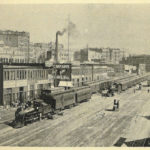
Types Of Steel Used In Automotive IndustryA lot like the metals business, automobile producers are continually and drastically investing in study and development, from developing new alloys and supplies with improved properties to perfecting the latest tactics in the welding and shaping of numerous materials and alloys. Considering that then aluminium has turn out to be a important manufacturing material in aviation. The composition of aluminium alloys utilized in aircraft has changed, aeroplanes have gotten greater, but the main objective of aircraft designers remains the identical: develop a plane that is as light as attainable with the maximum achievable capacity that utilizes the least achievable amount of fuel and whose body doesn’t rust over time. It is aluminium that enables aviation engineers to hit all these targets. In modern day aircraft aluminium is utilised literally everywhere: in the fuselage, in the trims, in wing panes and in the rudder, in the tie down systems in the exhaust pipes, in the feeding blocks, in the refuelling hoses, in the door and floors, in the frames of pilot and passenger seats, in the fuel nozzles, in the hydraulic systems, in the cabin pillars, in ball bearings, in the instrumentation in the cockpit, in the engine turbines and in lots of other areas.
WAS has completed a quantity of studies to examine AHSS with aluminum. 1st of all, AHSS can be manufactured at very thin gauges, but maintain the strength of a mild steel, which is distinct than the traditional steel that cars have been mostly made of a couple of decades ago. This permits the automotive designers to replace conventional steels with AHSS in the identical amount of packaging space.
Presently numerous higher end autos have austenitic stainless steel elements in their chassis and bodies. The additional price of this steel is becoming justified by light weight and the capability to match the element in a limited space. Several research have shown that it is possible to cold form complex components (such as B-pillars) with stainless steel. It is also feasible to hot form and quench the steels to obtain even far more strength.
Pitting Corrosion Of Martensitic Cutlery Steelsname four types of steel rules used in machine shop work
steel used in automobile industryHave you ever wondered precisely what your auto is made of? More than the years, steel has remained the key components in the automotive market. Steel has wide range of yield strength with higher modulus of elasticity. Steel is also deemed as most preferable material in automotive application due to low cost. Other advantages of steel contain light weighting possibilities employing new generation higher strength steel top to fuel efficiency, enhanced security, good recyclability, and formability qualities. This paper discusses the present trend, application and recent progress in usage of various types of steel in automobile sector. Recent development of next generation steel such as Sophisticated High Strength Steel (AHSS) has also been elaborated.
A second classification method crucial to element designers is strength of the steel. For that reason, the common terms HSS and AHSS are used to designate all higher strength steels. This classification program has a dilemma with the ongoing development of the many new grades for each sort of steel. Therefore, a DP (dual phase) or TRIP (transformation induced plasticity) steel can have strength grades that encompass two or much more strength ranges.
The main strengthening mechanism in standard HSS is strong-resolution hardening. In the bake hardening (BH) steels, the chemistry and processing are developed to take carbon out of remedy in the course of the paint baking cycle. In this way, the steel is created softer and more formable for the press shop, but it gains a lot more strength soon after becoming place in service. Carbon manganese steels are mild steel strong solution, strengthened by adding manganese alloy.
Materials Utilised In Automotive Manufacture And Material Choice Employing Ashby ChartsTypes Of Steel Used In Automotive Industry
four types of steel rulesNo matter whether metal is used to make tools, create skyscrapers, or lay railways, strength is an vital consideration when deciding which metal ideal suits the job. Subpart 1 includes allowable tension and design tension intensity tables for ferrous and nonferrous components for pipe, fittings, plates, bolts, and so forth. In addition, it gives tensile strength and yield strength values for ferrous and nonferrous materials, and lists elements for limiting permanent strain in nickel, higher-nickel alloys, and high-alloy steels.
Nowadays aircraft designers are hunting for new materials that supply all the positive aspects of aluminium but are even lighter. The only candidate they have is carbon fibre. It consists of threads in between five and 15 um in diameter comprising mostly carbon atoms. The first airliner with a fuselage made fully of composite components was the Boeing 787 Dreamliner, which made its maiden industrial flight in 2011.
While lightweighting is used to enhance the efficiency of automobiles, it could not be for the reasons you may consider. Just creating a automobile lighter through blind option is not the answer. Rather, design and style engineers have to take into account the optimum operational curve of contemporary engines and match a cars’ weights to it. In some situations, lightweighting might be more about hitting a target weight for a particular engine rather than making the vehicle as light as humanly feasible.
New Steel Grades Drive PMI Applications In Automotive ManufacturingThe Four Types Of Steel
four types of steel springSteel is ubiquitous in a vast quantity of industries, from residential, industrial and industrial construction, to shipbuilding and automotive, to manufacturing. Abstract: In this paper, ultra-higher strength dual phase steel was investigated. Thermomechanical processing was carried out by utilizing a laboratory hot rolling mill. The outcomes have shown that the major transformation products at three different sorts of thermomechanical processing had been ferrite, bainite, and tiny amounts of martensite. Laminar cooling led to ferrite grain refinement. The mechanical properties of specimen 1 which was controlled cooling after a relative lower temperature rolling are a lot higher than that of specimen two. The presence of martensite islands and precipitates contributed to the enhancement of strength of the present steel. And the presence of retained austenite resulted in greater toughness. As a result, these specimens exhibited satisfactory mechanical properties.
Aluminium usage in automotive industry has grown inside past years. In automotive powertrain, aluminim castings have been utilized for practically one hundred% of pistons, about 75% of cylinder heads, 85% of intake manifolds and transmission. For chassis applications, aluminium castings are employed for about 40% of wheels, and for brackets, brake components, suspension, steering components and unstriment panels. Aluminium is utilised for body structures, closures and exterior attachments such as crossbeams, doors or bonnets.
As there is a higher emphasis on greenhouse gas reductions and enhancing fuel efficiency in the transportation sector, the automobile sector is investing considerably in lightweight supplies. The sector is moving towards the objective of escalating the use of lightweight supplies. It is giving priority to the activities connected with the development of new components, forming technologies, and manufacturing processes. The weight reduction is nonetheless the most expense-effective implies to decrease fuel consumption and greenhouse gases. It has been estimated that for each and every 10 % of weight eliminated from a vehicle’s total weight, fuel economy improves by 7 %. This also implies that for each and every kilogram of weight decreased in a automobile, there is around 20 kg of carbon dioxide reduction.




